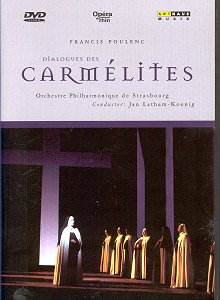 DVD
Review
DVD
Review
Francis POULENC (1899-1963)
Dialogues Des Carmélites
Opera in three Acts and Twelve Scenes
Blanche de la Force………… Anne Sophie Schmidt
Mère Marie de l'incarnation.. Hedwig Fassbender
Constance………………….. Patricia Petibon
Madame de Croissy………….Nadine Denize
Le Marquis de la Force…… Didier Henry
Le Chevalier de la Force….. Laurence Dale
 Orchestre Philharmonique de
Strasbourg
Orchestre Philharmonique de
Strasbourg
Choeurs de l'Opéra National du Rhin
Conducted by Jan Latham-Koenig
 ARTHAUS DVD 100 004 With
subtitles in English, German and Dutch [149
mins]
ARTHAUS DVD 100 004 With
subtitles in English, German and Dutch [149
mins]
Crotchet

The searing intensity of Poulenc's only full-length opera, Dialogues Des
Carmelites (about a group of nuns who were executed, at the time of the French
Revolution, as martyrs to their faith), may be, to some extent, a reflection
of the turbulence the composer was experiencing in his personal life at the
time (1953-56). Poulenc was concerned about his relationship with Lucien
Roubert, worried that he might have a stomach cancer, and depressed by the
funerary art and tombs he saw in Alexandria on a trip to Egypt which he had
embarked on with distinct lack of enthusiasm. Added to all this, there were
troubles about the stage rights to the Carmélites involving the heirs
of the librettist, Georges Bernanos. They approved Poulenc's idea to adapt
the work, but they were in no position to make a decision. Bernanos had written
the work for a film based on a novel, The Last to the Scaffold, by a German
writer, Gertrud von le Fort and the adaptation rights to the book had been
bought by an American screenwriter, Emmet Lavery. The Bernanos family disliked
the American intensely but, nevertheless, it was he who controlled the rights
to the Carmélites. After much negotiation, permission was granted
but Poulenc had to agree to have Lavery's name appear on every programme
and on the printed score. On a more positive level, Father Griffin, a
Carmélite priest from Dallas wrote to Poulenc and promised the
encouragement of prayers by every Carmélite in America.
The opera is characteristic of Poulenc's return to Catholicism beginning
in the '30s. The story centres around Blanche de la Force (who Poulenc regarded
as a kindred spirit). Act I opens in the household of the Marquis de la Force.
Since her mother's accidental death, Blanche has been oppressed by existential
fears. After being terrified by a shadow on a wall, she persuades her concerned
father and brother that she should become a Carmelite nun. But in Scene II
in the office of the Carmel of Compiègne, Blanche has to persuade
the Prioress Madame de Croissy who is suspicious of her motives, but she
is admitted when she reveals the nun's name that she wants to adopt - 'Sister
of Christ's Fear of Death'. Scene III is a dialogue between Blanche and the
other cheerful young novice sister, Constance with whom she shares work.
Constance is willing to sacrifice her life if it would save the dying Prioress.
But Blanche's fear of death makes her shrink from such a thought. Anne-Sophie
Schmidt as the neurotic yet essentially humble Blanche communicates her
character's vulnerability and torment very well, her singing nervously rapid
and humble. Patricia Petibon is a most appealing Constance. She radiates
a serene spiritual beauty and her coloratura singing is angelic.
In Scene IV of Act I the First Prioress dies in one of the greatest dramatic
moments of modern opera. Nadine Denize as the Prioress mesmerises in her
crisis of faith, communicating her hysteria and terror with great emotional
force while Poulenc's music counterbalances in solemnity and control. Act
II, Scenes I and II, with an intermezzo, concern first the death watch for
the Prioress which disturbs Blanche, who is still acutely afraid of death,
so much that she deserts her watch and incurs the anger of Mother Maria;
and then the choice of Madam Lidoine (Valérie Millot) instead of Mother
Maria as the new Prioress. Millot's long monologue allows her the opportunity
of displaying, to its best advantage, her dramatic soprano voice. The following
nun's Ave Maria chorus is humble yet very affecting. In Scene III, Blanche's
brother (an earnest and solicitous Laurence Dale) comes to plead in vain
for Blanche to return to her father where she would be safe from the
revolutionaries. In Scene IV the revolutionary commissioners announce the
dissolution of the cloister.
In Act IV the sisters, stripped of their cloth, take an oath of martyrdom.
Blanche flees to her father's house only to find he has been executed. Mother
Maria gives her an address where she might find refuge. Hedwig Fassbender
in the important linking role of Mother Maria beatifically communicates warmth
and compassion and understanding. This final Act culminates in the mass execution
of the nuns. As Constance, the last nun to be beheaded, walks to the scaffold,
Blanche finds the courage to face death and walks out of the crowd to join
her. The whole of this Opéra National du Rhin production has simplistic
sets with discreetly lit, large, plain shadowy pillars giving a sense of
church-like spaciousness and deep perspectives that seem to overwhelm adding
something to Blanche's sense of paranoia. Simplicity is the key to the execution
scene too. No scaffold, no block; the nuns stand in line across the stage
to come forward either singly or in pairs to fall to the ground at the sound
of a falling guillotine.
Jan Latham-Loenig leads the soloists, choirs and orchestra in a deeply moving
performance and the detailed sound reveals all the richness of Poulenc's
scoring including the dramatic Act III interlude music in which we have the
opportunity of appreciating some of his inventive scoring for percussion
utilising snare drum, tom-tom and wood block. A rewarding experience for
the adventurous.
Ian Lace


